Climate change and elevated CO2 (eCO2) has a marked effect on invasive species. eCO2 promotes growth, in absence of other limitations, and alters the nutritional values of leaves and other plant organs. Faster growth has the potential to offset the damage and biomass removal by herbivores, while decreased palatability can deter herbivores and even reduce herbivore fitness. As many biocontrol agents used in southern Africa are herbivores, climate change and eCO2 has the potential of effect their efficacy at controlling alien invasive plants.
Our work has explored this phenomenon on various aquatic weed systems. Water hyacinth or Pontederia crassipes is one of the world’s most invasive aquatic weeds. Two agents Cornops aquaticum and Megamelus scutellaris, each from very different feeding guilds, have good potential for controlling this weed. This study investigated their performance under current and future conditions, confirming that sap-feeding insects such as M. scutellaris will likely be better biocontrol agents through their ability to cause mechanistic damage to the plant instead of the surface level leaf removal exhibited by chewing insects.
eCO2 decreased the feeding damage caused by biological agents used to control the aquatic weeds Azolla filiculoides, Salvinia molesta, Pistia stratiotes and Myriophyllum aquaticum. Results suggest that the control of these aquatic pest will become more problematic in the future (Baso, 2020; Baso et al 2021).
Some submerged aquatic plants utilize HCO3- in preference to dissolved CO2. Five plant species utilising this source of carbon showed minimal responses to growth under eCO2 the treatment did effect plant nitrogen status with potential ecosystem effects (Hussner et al., 2019).
Research on invasive water weeds at the RUECF has been conducted by researchers from the Centre for Biological Control (https://www.ru.ac.za/centreforbiologicalcontrol).
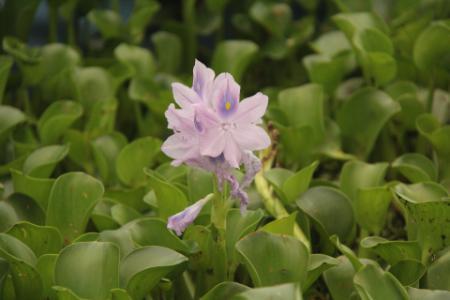
Photo cred: Centre for Biological Control
Water hyacinth or Pontederia crassipes is one of the worlds most invasive aquatic weeds, to control this weed in the present climate in South Africa we have 9 biological control agents. These biological control agents range from large defoliating grasshoppers to minute gallery forming mites. The two most promising agents we currently have are a semi aquatic grasshopper called Cornops aquaticum and a plant hopper called Megamelus scutellaris. Both represent very different feeding guilds and are perfect subjects to study how future climates and elevated CO2 may impact biological control efforts of water hyacinth in the future. We tested the reponse of water hyacinth and the biological control agents to eCO2 by measuring photosynthetic rates and physical plant responses of water hyacinth as well as the feeding impact and population responses of our agents.
Researchers involved: Matthew Paper (m.paper@ru.ac.za, Centre for Biological Control), Thomas Righetti (FuDei research group, Argentina), Esther Mostert, Prof. Julie Coetzee, and Prof. Martin Hill.
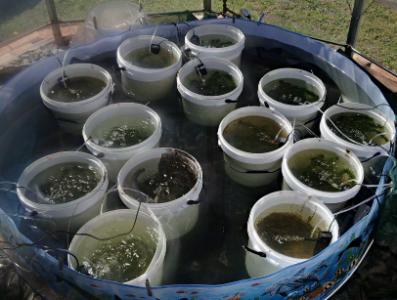
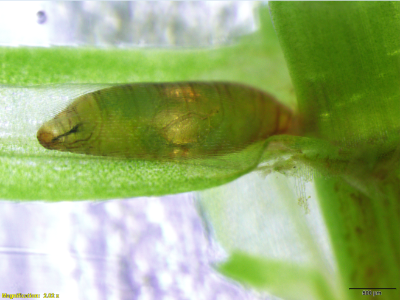
Photo cred: Rosali Smith
Egeria densa Planchon (Hydrocharitaceae) is a submerged aquatic weed that has become problematic in South Africa. We wanted to evaluate the performance of its biological control agent, a leaf-mining fly, Hydrellia egeriae Rodrigues (Diptera: Ephydridae) when fed with plants grown under elevated CO2 levels. Primarily, E. densa was planted at low and high densities, to imitate different levels of invasion and grown at 400ppm, 600ppm and 800ppm levels. This enabled us to predict if E. densa nutritional quality would differ between invasion densities under climate change conditions . Secondly, the performance of the biological control agent was evaluated over five generations using plants grown only at high densities.
Researchers involved: Rosali Smith (rosalismith2@gmail.com, Centre for Biological Control), Esther Mostert, Dr Andreas Hussner, and Prof Julie Coetzee.
Invasion and control of various water weeds at elevated CO2
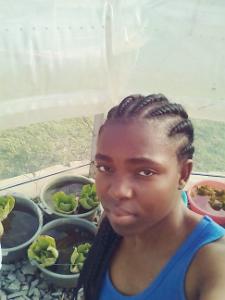
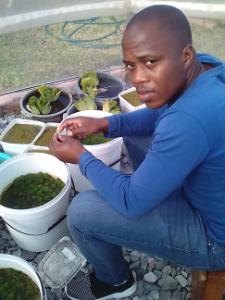
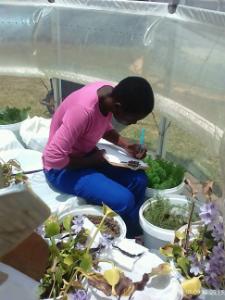
Photo cred: Nompumelelo Baso
This study aimed to investigate the effects of elevated atmospheric CO2 on the biological control of four invasive aquatic weeds that are currently under successful control by their respective biological control agents in South Africa. The species studied were Azolla filiculoides, Salvinia molesta, Pistia stratiotes, and Myriophyllum aquaticum. The plants were grown at ambient (400 ppm) or elevated (800 ppm), and plants were either subjected to or not subjected to herbivory by their target biological control agents. There was an overall increase in biomass production and Carbon:Nitrogen across all species at elevated CO2, both in the absence and presence of biological control. Insect feeding damage was reduced by elevated CO2.
Researchers involved: Nompumelelo Baso (g14b4197@campus.ru.ac.za, Centre for Biological Control), Prof Julie Coetzee, Prof Brad Ripley, and Prof Martin Hill. Assisted by Wandisile Mdiza.
Associated Publications
Baso N.C. (2020) MSc, Rhodes University.
Baso, N.C., Coetzee, J.A., Ripley, B.S. and Hill, M.P., 2021. The effects of elevated atmospheric CO2 concentration on the biological control of invasive aquatic weeds. Aquatic Botany, 170, p.103348. Baso et al., 2021
Hussner, A., Smith, R., Mettler-Altmann, T., Hill, M.P. and Coetzee, J., 2019. Simulated global increases in atmospheric CO2 alter the tissue composition, but not the growth of some submerged aquatic plant bicarbonate users growing in DIC rich waters. Aquatic Botany, 153, pp.44-50. Hussner et al., 2019
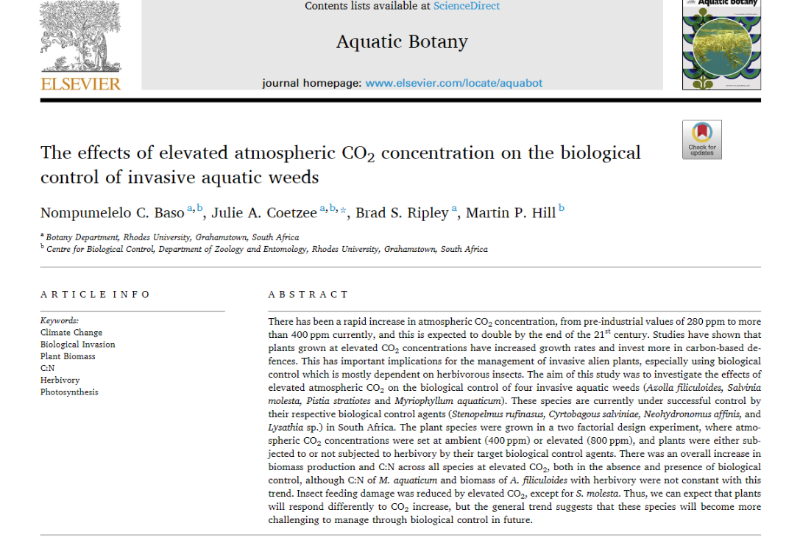
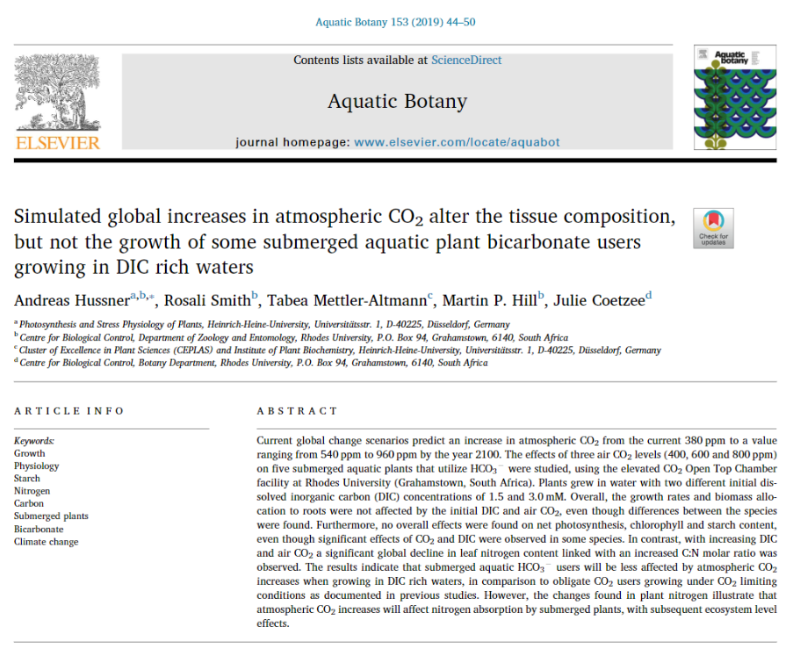
Last Modified: Tue, 15 Feb 2022 14:56:10 SAST